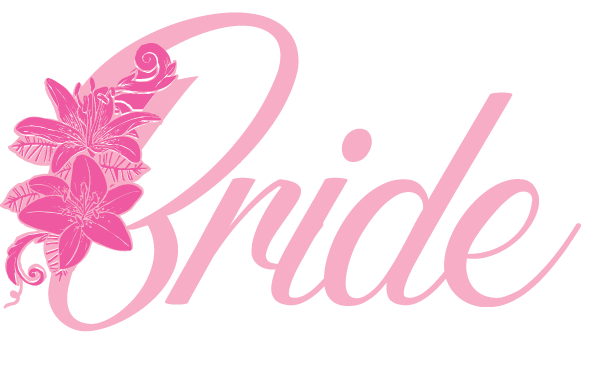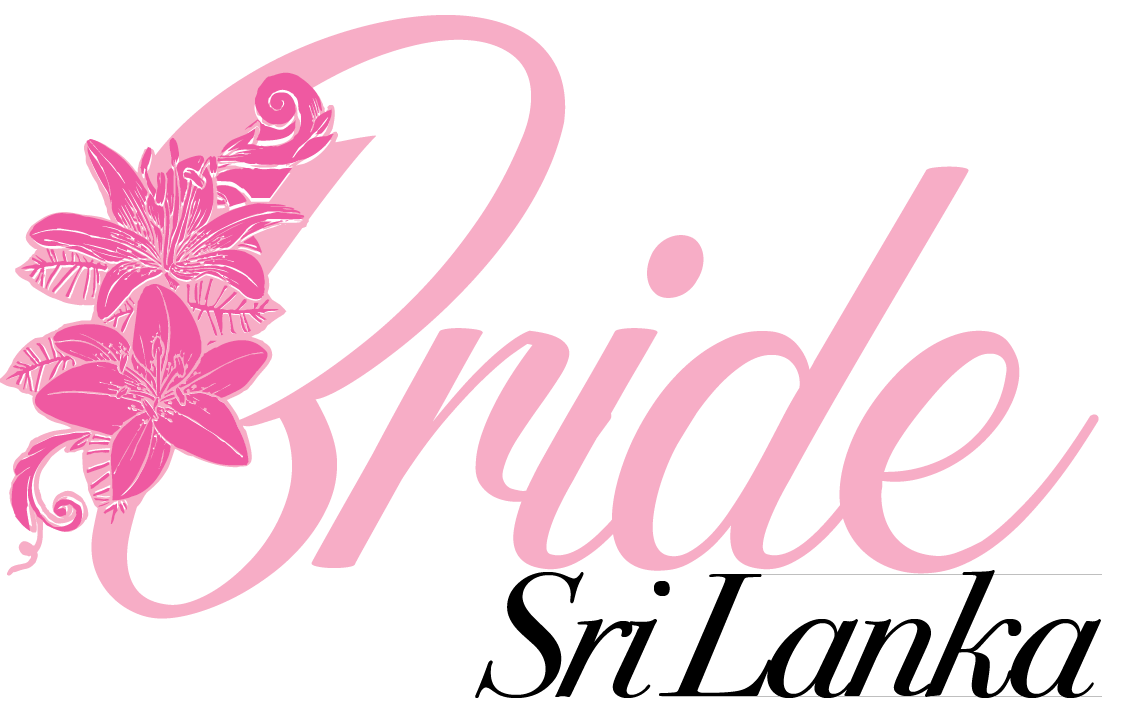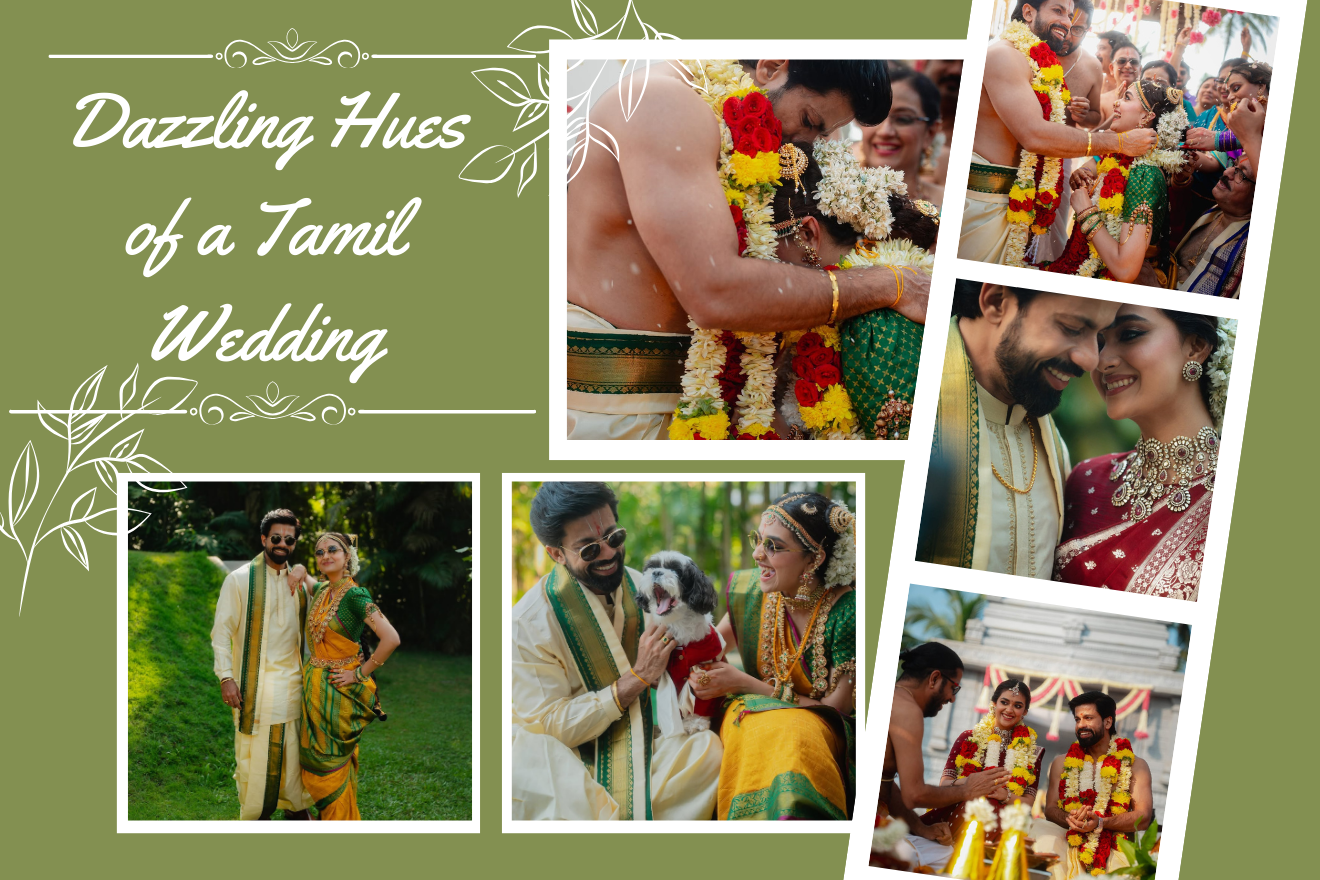Tamil weddings are a breathtaking kaleidoscope of color, culture, and tradition, weaving together centuries-old customs with the joyous celebration of love. Rooted in the rich heritage of South India and Sri Lanka, these weddings are more than just a union of two souls—they are a vibrant spectacle that captivates the senses. From the radiant reds and golds of the bride’s attire to the lush greens and yellows adorning the venue, every hue tells a story of devotion, family, and festivity(Dazzling Hues of a Tamil Wedding). For brides planning their dream day, understanding the role of color in a Tamil wedding offers a window into creating a celebration that’s both deeply meaningful and visually stunning.
The Symbolism of Color in Tamil Weddings
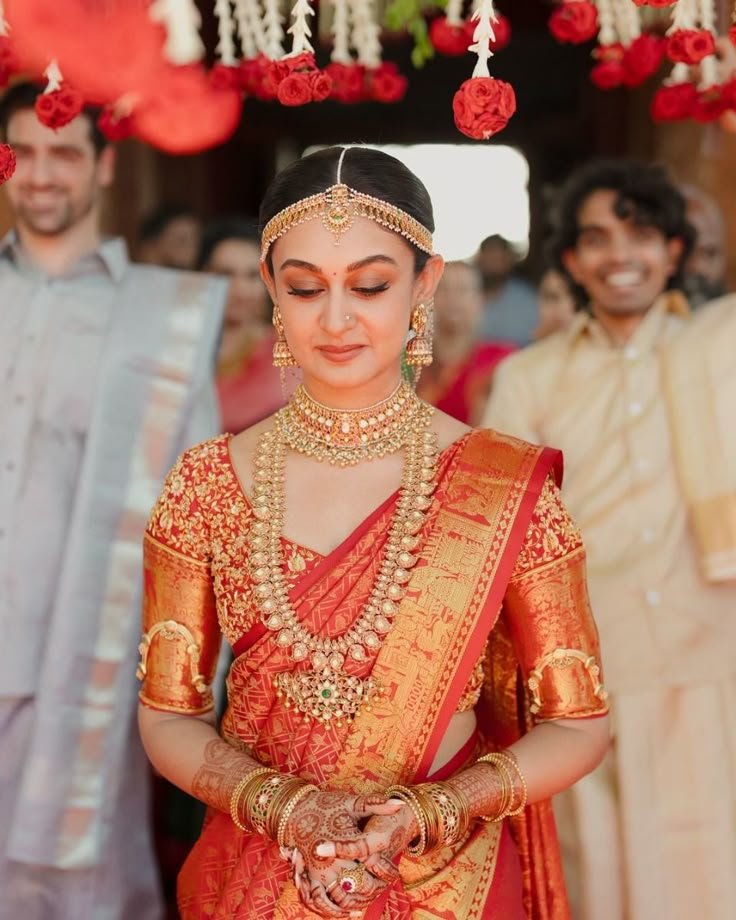
In Tamil culture, colors are not just decorative—they carry profound symbolic weight. Red, for instance, is the heartbeat of the Tamil wedding palette. It signifies passion, fertility, and prosperity, making it a staple in the bride’s wardrobe. The traditional Tamil bride dazzles in a Kanjeevaram silk saree, often dyed in rich shades of crimson or maroon, with intricate gold zari work that shimmers under the sunlight. This isn’t merely a fashion choice; it’s a nod to the auspiciousness of the occasion, a prayer for a fruitful married life.
Gold, too, reigns supreme. Beyond its aesthetic appeal, gold represents wealth, divine blessings, and purity. From the bride’s jewelry—heavy necklaces, jhumkas, and maang tikkas—to the groom’s veshti bordered with golden threads, this metallic hue ties the couple to a legacy of abundance. Meanwhile, yellow and green weave their way into the ceremony through turmeric-smeared rituals and banana leaf decorations, symbolizing growth, harmony, and new beginnings. Even the humble white of the groom’s attire or the jasmine flowers in the bride’s hair speaks to purity and simplicity amidst the riot of color.
The Bride: A Vision in Scarlet and Gold

For a Tamil bride, the wedding day is her moment to shine, and her attire is the centerpiece of this vibrant tableau. The Kanjeevaram saree, handwoven in Tamil Nadu, is a masterpiece of craftsmanship. Its bold reds, pinks, or even deep blues are offset by contrasting borders in gold or silver, often adorned with motifs of peacocks, lotuses, or paisleys. Draped elegantly over her shoulder, the saree transforms her into a living embodiment of tradition and grace.
But it’s not just the saree that dazzles. The bride’s jewelry is a cascade of color and light—gold bangles clinking with every movement, ruby-encrusted necklaces that catch the eye, and emerald earrings that hint at nature’s bounty. Her hands and feet are adorned with intricate mehndi, its earthy brown patterns a striking contrast to the bright silks. And let’s not forget the flowers—jasmine garlands woven into her hair release a sweet fragrance, their snowy petals a soft counterpoint to the vividness around her. This harmonious blend of colors doesn’t just beautify the bride; it tells the world she’s stepping into a new chapter with pride and reverence.
The Groom: Subtle Elegance in Tradition
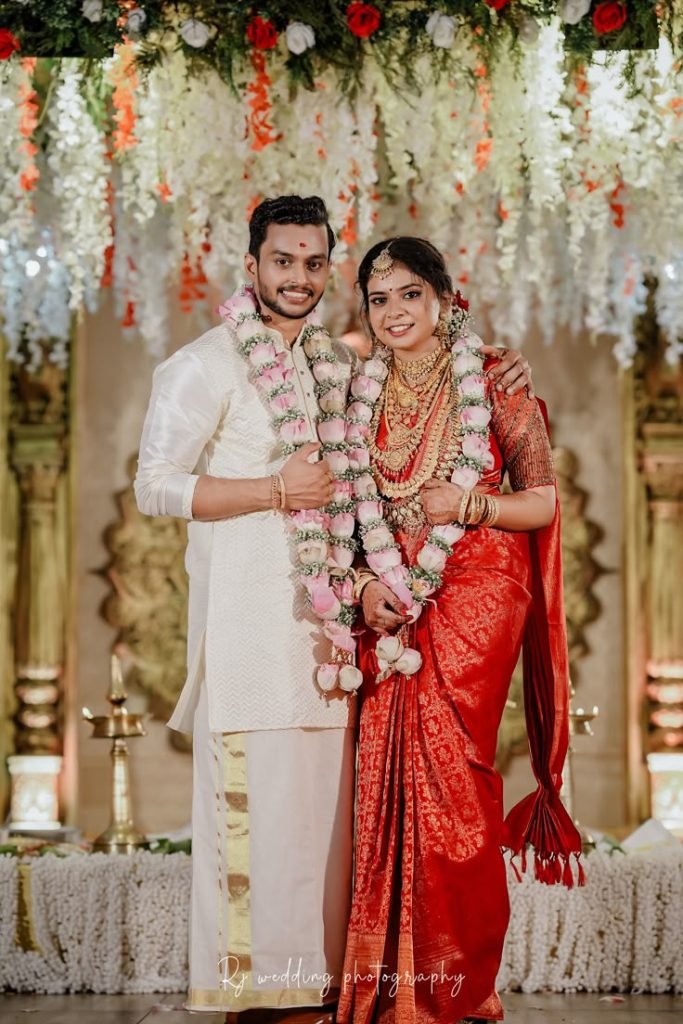
While the bride steals the spotlight, the groom’s attire complements her vibrancy with understated elegance. A traditional Tamil groom often wears a veshti, a crisp white dhoti with a golden border, paired with a silk shirt in cream, beige, or even a muted pastel. Some opt for a sherwani in richer tones like maroon or navy, embroidered with delicate threads that echo the bride’s grandeur. His turban or headpiece, if worn, might feature a splash of color—perhaps a red gem or a golden band—tying him to the celebratory palette. Together, the couple’s contrasting yet cohesive looks create a visual harmony that’s as symbolic as it is stunning.
The Venue: A Canvas of Festivity
Step into a Tamil wedding venue, and you’re enveloped in a burst of color that feels alive. Marigold garlands in fiery orange and yellow drape the entrance, their cheerful tones welcoming guests with warmth. Banana leaves, lush and green, line the dining tables, offering a natural vibrancy that’s quintessentially Tamil. The mandap—the sacred space where vows are exchanged—is a riot of hues, adorned with silk fabrics, floral arrangements, and rangoli patterns in chalky whites, pinks, and blues. Even the kolam designs at the doorstep, drawn with rice flour, explode with symmetry and color, inviting prosperity into the home.
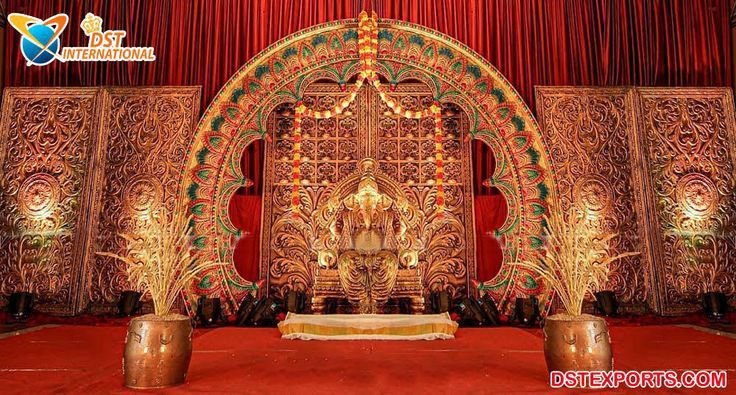
Lighting plays its part too. Golden oil lamps cast a warm glow, while fairy lights in soft whites or bold reds amplify the festive mood. Every corner of the venue pulses with life, reflecting the joy of the occasion and the community’s collective spirit.
Rituals Painted in Color – Dazzling Hues of a Tamil Wedding
The rituals of a Tamil wedding are as colorful as the decor. Take the haldi ceremony, where the bride and groom are smeared with a golden turmeric paste, believed to purify and bless them. The bright yellow stains linger on their skin, a mark of celebration. During the Kasi Yatra, the groom playfully pretends to renounce worldly life, only to be persuaded back with a garland of flowers—often red and white—by the bride’s brother. And then there’s the tying of the thaali, the sacred yellow thread dipped in turmeric, which the groom fastens around the bride’s neck as the crowd erupts in cheers.
Food, too, adds to the palette. Served on banana leaves, the feast features a rainbow of flavors—red-hued sambar, golden rasam, green chutneys, and white rice dotted with colorful curries. Each bite is a testament to the vibrancy of Tamil hospitality.
Modern Twists on a Timeless Palette
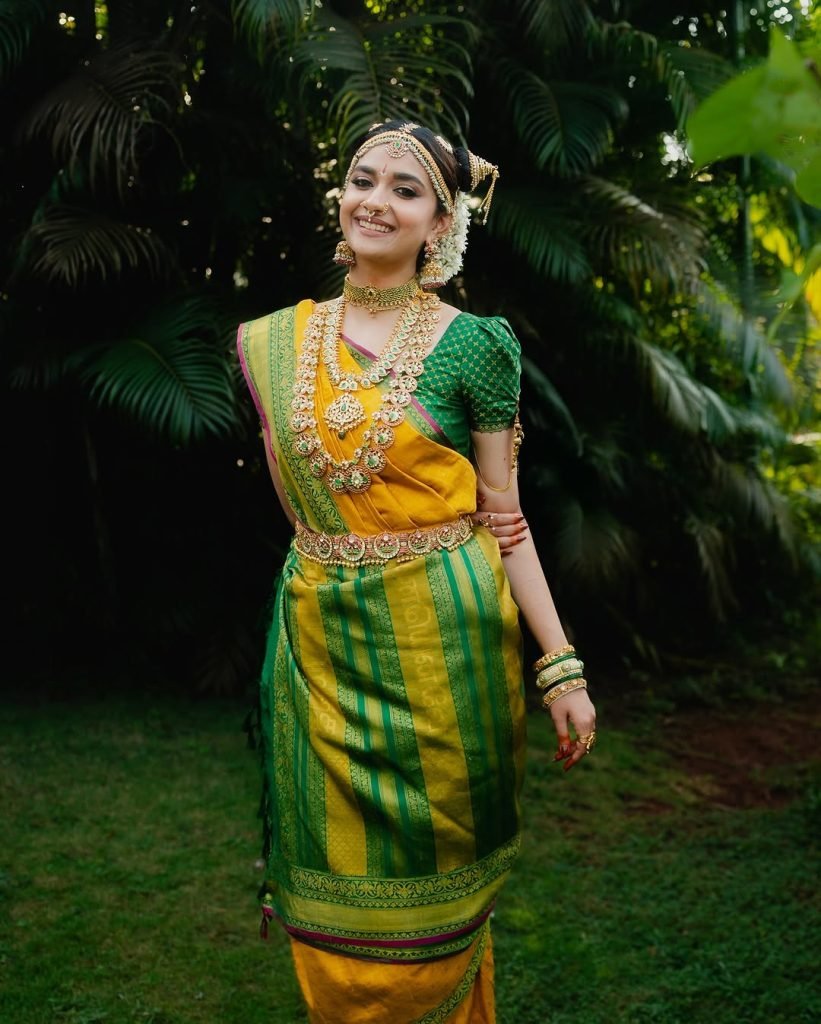
Today’s Tamil brides and grooms are blending tradition with contemporary flair, and color remains at the heart of this evolution. Some brides experiment with pastel sarees—soft pinks, lilacs, or mint greens—while keeping the gold accents intact. Others incorporate fusion elements, like lehenga-style drapes or floral jewelry in unconventional shades like lavender or peach. Grooms, too, are stepping out in bolder hues, swapping traditional whites for deep blues or earthy browns. Venues might feature modern decor—think neon signs or ombre backdrops—while staying rooted in the classic Tamil color story.
This fusion doesn’t dilute the vibrancy; it amplifies it, proving that Tamil weddings can evolve while honoring their roots. For Sri Lankan Tamil couples, the influence of island culture adds another layer, with tropical motifs or sea-inspired blues subtly woven into the celebration.
Planning Your Colorful Tamil Wedding
For brides dreaming of their own Tamil wedding, the key is balance. Choose a saree that speaks to your personality—whether it’s a fiery red or a regal purple—and let your jewelry amplify its hues. Coordinate with your groom for a unified yet distinct look, perhaps matching his veshti border to your saree’s accents. Work with your decorator to weave traditional colors into the venue—marigolds, turmeric, and silk are non-negotiables—but don’t shy away from a personal touch, like a favorite shade or a modern twist.
Most importantly, let the colors tell your story. A Tamil wedding isn’t just a day; it’s a legacy painted in the boldest, brightest strokes. As you step into this new chapter, surrounded by the dazzling hues of tradition, you’ll find that every shade—red for love, gold for blessings, green for growth—holds a promise for the life ahead.
